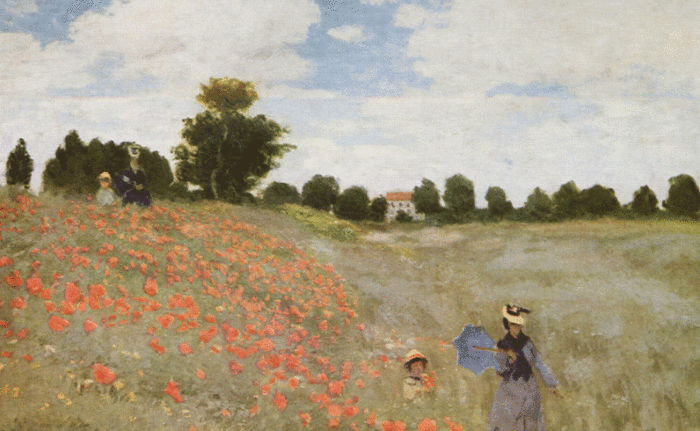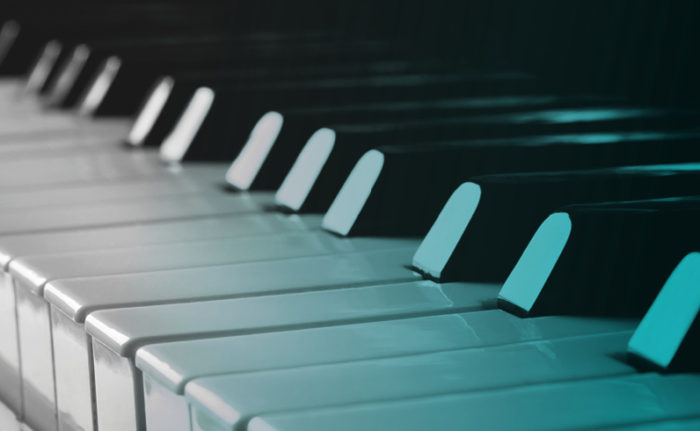On November 22, 23, and 24, the Houston Symphony presents Trifonov Plays Tchaikovsky, a program featuring world-renowned virtuoso Daniil Trifonov in Tchaikovsky’s Piano Concerto No. 1, plus Ravel’s vibrant orchestration of Mussorgsky’s Pictures at an Exhibition. In this post, discover the pictures that inspired this musical art gallery. Learn more about Mussorgsky’s masterpiece in our podcast.
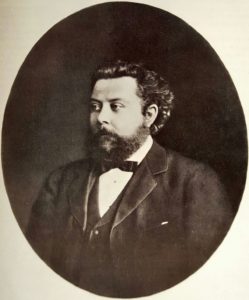
One of Modest Mussorgsky’s best friends was Viktor Hartmann, an artist who tragically died of an aneurism in 1873 at the age of 39. Two weeks after Hartmann’s death, his friends and supporters organized a major exhibition of his works at the Imperial Academy of Arts in St. Petersburg. About a year later, Mussorgsky composed Pictures at an Exhibition. Completed in only twenty days, Pictures was originally a set of short pieces for piano in which Mussorgsky depicted himself walking through the exhibition and contemplating Hartmann’s works. For millennia, poets have boasted of their power to bestow immortality on those they honored in verse; Pictures is Mussorgsky’s attempt to bestow immortality on Hartmann. Most of the works that inspired Pictures have been lost to the ravages of time; it is through Mussorgsky’s music that they are remembered.
Mussorgsky must have played through Pictures privately for his friends, but there is no record of any public performance during his lifetime. After Mussorgsky’s own untimely death, the piece languished in obscurity. It only entered the standard repertoire when the conductor Serge Koussevitzky commissioned Maurice Ravel’s celebrated orchestration in 1922.
The Pictures
The piece begins with what Mussorgsky called a “Promenade in modo russico”:
https://www.youtube.com/watch?v=syLm-9JyhuY&t=26s
Promenade is French for “a walk,” and “in modo russico” is Italian for “in the Russian style.” A kind of musical self-portrait, it depicts Mussorgsky walking into the great hall of the Imperial Academy. The Promenade melody reappears throughout Pictures as Mussorgsky walks from one work of art to another.
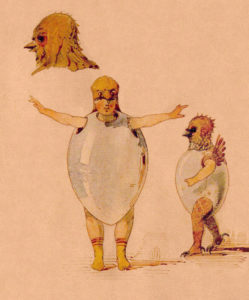
The first picture is Gnomus, Latin for “gnome.” The critic Vladimir Stasov (a steadfast friend to Mussorgsky), tells us that this movement was inspired by a design for a nutcracker: “a fantastic lame figure on crooked little legs.”
The next picture is Il Vecchio Castello, Italian for “the old castle.” Although the original picture has been lost, it was based on an architectural sketch into which Viktor Hartmann inserted a tiny troubadour for scale. Mussorgsky seems to have imagined the Italian setting, evoked by the gentle rhythms of the siciliano. Ravel gave the troubadour’s song to the saxophone.
The next picture, Tuileries, was inspired by a now lost crayon drawing of the Tuilerie Gardens in Paris. For scale, Hartman added figures of children playing with their nurse. The music depicts the children’s games. Rosa Newmarch, an early champion of Mussorgsky’s music, commented that the opening melody may represent the children’s teasing calls of “Nianya, Nianya” or “nanny, nanny” in Russian.
The next picture, Sandomirzsko bydlo (le télégue), combines Polish and faux-French: in Polish, the word “bydlo” means “cattle.” “Le télégue” is a Frenchified version of the Russian word “telega,” which means “cart,” and “Sandomirzsko” indicates that this cart is from Sandomir, a Polish province Hartmann visited. This picture does not survive, but Mussorgsky likely had in mind a large cart pulled by cattle and driven by a weather-beaten peasant. It appears immediately, without an intervening Promenade, and the cinematic montage of happy children playing in Paris with the grinding toil of a Polish peasant is striking. In the first edition of Pictures, Nikolai Rimsky-Korsakov changed the fortissimo at the beginning of Bydlo to a pianissimo, creating the impression of a cart approaching from a distance, passing by, and fading away. Working from Rimsky-Korsakov’s edition, Ravel created a masterful crescendo with the orchestra.
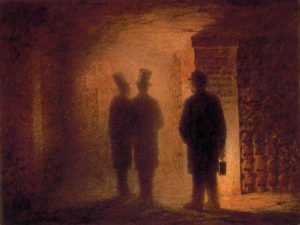
The next picture is The Ballet of the Unhatched Chicks. According to Stasov, “Hartman designed the costumes for the staging of the ballet Trilbi at the Maryinsky Theatre, St. Petersburg. In the cast were a number of boy and girl pupils from the theatre school, arrayed as canaries. Others were dressed up as eggs.”
In another of Mussorgsky’s musical montages, the next picture, Samuel Goldenberg and Schmuÿle, appears without an intervening Promenade. Stasov explained, “Viktor Hartmann gave Mussorgsky two of his sketches from real life, those of the rich and the poor Jew. […] Mussorgsky was most delighted with the expressiveness of these pictures.” Like the lost Bydlo picture, these portraits came from the time Hartmann spent in Sandomir. Mussorgsky likely invented their names himself. First, we meet Samuel Goldenberg, the wealthier of the two; Mussorgsky gives him a deep, booming voice. Mussorgsky depicts the poor Schmuyle, by contrast, with a melody full of repeated notes that depict his shivering in the cold; Ravel scored it as a trumpet solo.
In Mussorgsky’s original piano version, a final Promenade appeared before the next picture, but Ravel omitted it. Now there are no more interruptions between pictures; instead, the Promenade melody appears within other movements as Mussorgsky is drawn into the works of art. Next, we are back in France, this time at the marketplace in the town of Limoges. The picture for this movement has been lost, but Stasov tells us the music illustrates “the crowd shrieking, disputing, chattering and quarrelling in the marketplace.”

In the starkest of Mussorgsky’s musical montages, the next movement begins without pause, transporting us from the world of the living to that of the dead. This movement is titled “Catacombae: Sepulchrum Romanum,” which is Latin for “Catacombs: Roman Sepulchre.” Hartmann’s watercolor actually depicts the catacombs of Paris, which hold the skeletal remains of more than six million people. Two men in top hats whisper to each other, accompanied by a third man holding a lantern that illuminates rows of neatly arranged skulls. Surely, this picture reminded Mussorgsky of his friend’s untimely death. A series of strange, often dissonant harmonies rings out in the darkness, the alternation of loud and soft a kind of written-out reverberation that suggests the cavernous space. A tam tam fades into what Mussorgsky marks as a new section of the movement: “Cum mortuis in lingua mortua”— “with the dead in a dead language.” The Promenade theme returns in the oboe as high, tremolo violins evoke the flickering light. Perhaps Mussorgsky is imagining himself in the catacombs. Near the end, the music brightens, and Ravel adds a hint of the heavenly with harp arpeggios.
This peaceful mood is shattered by the next movement: The Hut on Hen’s Legs. In Russian folklore, Baba Yaga is a witch who flies through the woods on a mortar and pestle, searching for children to eat. She lives in a hut on hen’s legs that stalks the land. This movement was inspired by Hartmann’s design for an ornate clock in the shape of Baba Yaga’s hut. In the music, one can hear the clock ticking, another traditional symbol of mortality.
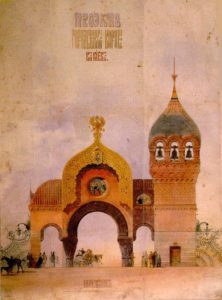
Suddenly, the specter of Baba Yaga is banished by a resplendent chorale. We have reached the final picture: The Great Gate at Kiev. Hartmann’s design for this monumental gate survives; it shows a grand, arched entryway connected to a chapel and a bell tower with a dome in the shape of a Slavonic helmet. The main “gate” melody alternates with the Russian hymn, “As you are baptized in Christ,” scored softly by Ravel for woodwinds. The distinctive sound of Russian church bells emanates from the gate’s tower, above which the Promenade theme returns: Mussorgsky appears to us once more, now fully in the world of the pictures. Ravel unleashes the full power of the orchestra for the climactic return of the great gate theme. Hartmann’s gate was never built, but here, his and Mussorgsky’s vision of art becomes reality. Mussorgsky’s music may not have been able to save all of Hartmann’s pictures, but whenever Pictures at an Exhibition is performed, they are brought to life again.
Want to learn more about Pictures at an Exhibition? Check out our podcast, featuring musician interviews, extensive musical excerpts, and more!
Don’t miss Trifonov Plays Tchaikovsky November 22, 23, and 24! Learn more & get tickets.

